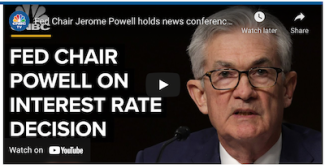
Market reactions to current events
When I was a stockbroker in 1984 markets were moved each month with the M-1 numbers emphasized by Milton Friedman. M-1 relates to the liquid money supply. Next were monthly inflation numbers, monthly GDP numbers, unemployment, and oil prices, and so on. Positive news for the economy would impact markets negatively. Negative news would move markets higher. This leads to the good news is bad news, the bad news is good news and the good news is good news depending on more indicators.
Inflation is back on the table for the first time in a long time with the Federal Reserve policy going forward. Earlier in the week, influenced by anticipation for the Federal Reserve Board meeting and high producer price index numbers, markets sold off. The sell-off continued through Wednesday morning until the report from the Federal Reserve meeting that bond-buying will stop sooner than expected and interest rates should rise. In 2022 the expectation is that the Fed will raise rates 3 times and then continue raising in 2023.
Markets then rallied from morning declines to significant gains by the close on Wednesday. The inflation rate target for the Fed is 2% and they expressed confidence that that goal has been met. The unemployment rate expectation is 4% and they are projecting an unemployment rate of 3.5% for 2022. Despite the Fed’s stated indications for 2022, markets seem to feel that the Fed’s previous planning had been adjusted based on the current economic environment. Market history says that there are short-term concerns as the Fed raises rates. However, with interest rates so low and the economy growing, the impact might be less severe. On the other side is the extremely high asset valuations that make market averages vulnerable.
We have mentioned the great resignation (https://www.sasadvisors.com/blog/great-resignation) and some recent research sheds some light on what is going on. It appears that most of the workers leaving the workforce are not leaving because of government aid. The research bears out that most job resignations do not consist of young Americans as sometimes believed. Most workers leaving the workforce are older and are retiring.
Reference link: https://www.cnn.com/2021/12/15/economy/labor-force-retirement-great-resignation/index.html
Even still, as vaccination rates and booster rates rise, seniors are slowly coming back to the workforce.
This website is informational only and does not constitute investment advice or a solicitation. Investments and investment strategies recommended in this blog may not be suitable for all investors. SAS Financial Advisors, LLC and its members may hold positions in the securities mentioned within this newsletter.
The SAS Newsletters are posted on the SAS Blog weekly: https://www.sasadvisors.com/blog

